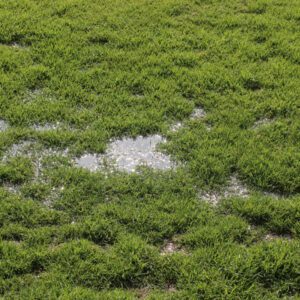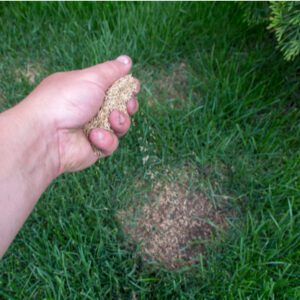As summer begins to wind down here in Ohio and fall quickly approaches, it’s time to start thinking about fall lawn care. Our mid-west summers can be harsh on even the healthiest lawns as excessive foot traffic, drought, and high heat can cause stress, damage, and fatigue. If your grass shows bare patches and is spongy in certain areas, you have compacted soil. Soil compaction occurs when there is too much thatch built up between your soil and your grass.
What is Thatch?
Thatch is the name for broken down organic materials such as leaves and grass clippings that settle on the soil. Over time, this layer gets thicker and thicker until even water is unable to penetrate through. This causes too much thatch, and soil compaction occurs. It prevents water, air, and other essential nutrients from getting to the roots of your grass where it is needed most.
When your lawn starts to show signs of soil compaction, you might initially think that your grass is suffering from lack of water or exhibiting signs of other lawn diseases. Pay attention when you water these spots. Does the water soak into the ground or runoff? 
Other symptoms to look for when it comes to compacted soil include:
Standing Water
Compacted soil exhibits other telltale signs such as pooling or standing water. When soils are so dense that they can’t absorb the moisture, it can collect in pools of water, turning into breeding grounds for mosquitoes.
Spongy or Squishy Grass
Spongy or squishy grass is a direct symptom of the thatch buildup on top of the soil. Not only does it strangle the grass, but it also attracts lawn pests such as mole crickets.
Weak or Yellowing Grass
Your grass will start to appear tired, exhausted, and begin to yellow.
Hard soil
When your soil is hard, mineral particles are pressed together too closely, and air, water, and nutrients are unable to reach your roots.
If you want to test your lawn to be sure, you can apply what is called the screwdriver test. Take a screwdriver and push it into the soil. If there is soil stuck to it, that means the soil is moist. If it’s clean or it was hard to push through, then your soil needs aeration.
So How Do We Solve This Problem of Thatch and Soil Compaction?
In order to eliminate thatch and bring your lawn back to life, you need to invest in the process of aeration. Aeration is the process of using a specialized machine to extract hundreds of tiny plugs from your turf and redistribute them across your lawn. Doing so basically allows your grass to breathe again. It loosens and breaks up thatch and allows the fertilizer, water, and air to flow back into the soil. Fall aeration offers a multitude of benefits for your lawn, including:
- Deeper stronger root growth
- Thicker, healthier grass
- Grass that grows much easier
- Bald and thin patches filled in
- A healthier, stronger turf

When is the Best Time to Aerate?
Aerating a lawn should be done once a year, or at least every other year. It should only be done during the growing season, as this will allow your lawn to quickly recover after the service. Here in Cincinnati, the best time to aerate is in the fall.
Overseeding
After aerating your lawn, it is ready for overseeding. Overseeding is the spreading of different types of grass over your existing grass. The new seeds will fill in bare spots and make your grass more robust by becoming more resilient to stresses from drought and disease. Benefits of overseeding your turf include:
- Filling in any bare areas
- Create thicker grass and prevent weeds
- Fend off pests, drought, and disease
- Enhance appearance and color
Get the Professional Service You Need from Turf Pro Plus
The professionals at Turf Pro Plus are specialized in providing you with superior lawn care services. We offer aeration and overseeding, and now is the perfect time to schedule that appointment. Your lawn needs a boost. Learn more or call us at 513-545-6295 and request an estimate now. Want to get to know us more personally? Follow us on Facebook.